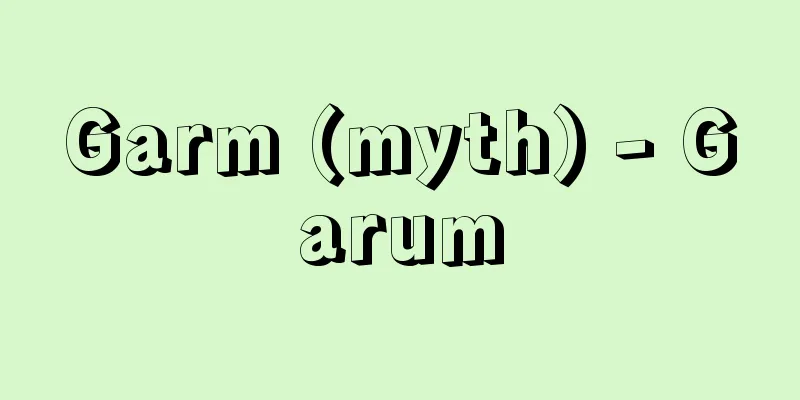Ape-man

|
If human evolution is divided into four stages, this refers to the first stage. Australopithecines belong to this category. Homo habilis is considered to be the bridge between ape-men and early man. At the end of the 19th century, E. Haeckel, who believed in evolutionary theory, saw the link between ape-men and humans as the missing link, and gave it the name Pithecanthropus (a compound word of the Greek words ape and man, meaning ape-man). Later, Pithecanthropus erectus (Java man) and Sinanthropus pekinensis (Beijing man) were considered to correspond to this link, and ape-men and early man were treated as synonyms. However, around 1945, australopithecines were reconfirmed, and as research on them progressed, ape-men and early man came to be considered to be at different stages. Australopithecines were included in the former, and Pithecanthropus in the latter. On the other hand, there is also the term man-ape, and in the 1950s, debates continued as to whether this term was more appropriate, or ape-man. Both ape-man and man-ape are intermediate between humans and monkeys, with the former being closer to humans and the latter closer to monkeys, but since the discovery of Zinjanthropus along with crude pebble tools by Mr and Mrs Leakey in 1959 at the Oldway ruins in Tanzania, it has finally come to be regarded as an ape-man, an animal with culture. Although there are many differences among fossil specimens belonging to australopithecus, all of them had an upright posture (bipedal walking), as evidenced by the shape of the pelvis and the position of the foramen magnum at the base of the skull. It is therefore presumed that the upper limbs were freed from walking and were free enough to use tools. In addition, shortened canines can no longer be considered fangs. These are human characteristics. However, their brain volume was about 500 milliliters, which is the same as that of modern great apes or only slightly larger. Today, australopithecus research is considered to be the key to unlocking the mysteries of human evolution. [Shise Kahara] [Reference] | |"Lucy" (Australopithecus afarensis) Late Pliocene period, Neogene period, Cenozoic Era, excavated from Hadar, Ethiopia, Photo/Fukui Prefectural Dinosaur Museum Image Library "> Australopithecus fossil bones Source: Shogakukan Encyclopedia Nipponica About Encyclopedia Nipponica Information | Legend |
|
人類進化を4段階に分けた場合、その最初の段階のものをいう。アウストラロピテクス類がこれに属する。ホモ・ハビリスは猿人と原人の橋渡しをするものと考えられる。19世紀末E・ヘッケルは進化論を信奉し、サルとヒトをつなぐものをミッシングリンク(失われた鎖の意)だとみて、これにピテカントロプス(ギリシア語のサルとヒトの合成語で、猿人の意)なる名を与えた。その後、ピテカントロプス・エレクトゥス(ジャワ原人)やシナントロプス・ペキネンシス(北京(ペキン)原人)などがそれに相当すると考えられ、また、猿人と原人は同義語として取り扱われた。しかし、1945年ごろよりアウストラロピテクス類が再確認され、その研究が進むにつれて、猿人と原人とは段階を異にするものとみなされるに至った。前者にはアウストラロピテクス類、後者にはピテカントロプス類が組み入れられた。また一方、人猿man-apeということばもあり、50年代には、猿人とどちらが適当かということで討議が続けられた。猿人も人猿もヒトとサルの中間的なもので、前者はそのなかでもヒト寄り、後者はサル寄りということになるが、59年、リーキー夫妻によりタンザニアのオルドワイ遺跡からジンジャントロプスが粗製の礫石器(れきせっき)を伴って発見されて以来、文化をもつ動物として、最終的に猿人とみなされるに至った。 猿人に属する化石標本にはいろいろな違いがあるが、すべて直立姿勢(二足歩行)をとっていたことが、骨盤の形態や頭蓋底(とうがいてい)における大後頭孔(だいこうとうこう)の位置から証明されている。したがって、上肢は歩行から解放され、道具を使用するのに十分自由であったと推定されている。また、短縮した犬歯はもはや牙(きば)とはいえない。これらは人類的特徴である。しかし、脳容積は約500ミリリットルで、現生大型類人猿と等しいか多少大きめにすぎない。今日、猿人研究は人類進化を解く鍵(かぎ)とみなされている。 [香原志勢] [参照項目] | |"Lucy"(アウストラロピテクス・アファレンシス〈ルーシー〉) 新生代新第三紀鮮新世後期 エチオピア ハダール出土写真/福井県立恐竜博物館画像ライブラリー"> アウストラロピテクスの化石骨 出典 小学館 日本大百科全書(ニッポニカ)日本大百科全書(ニッポニカ)について 情報 | 凡例 |
>>: Engine - engine (English spelling)
Recommend
Kawasaki [city] - Kawasaki
A city in the eastern part of Kanagawa Prefecture,...
vidhi
...The books that set out the rules are also call...
Iwakunisho - Iwakunisho
… [Hajime Miura] [Iwakuni Castle Town] Ishikuni S...
Green plants - Green plants
A general term for plants that use the energy of s...
Mount Kuroso
It is also called "Kurusoyama". It is on...
Irediparra gallinacea (English spelling)
...As soon as the chicks hatch from the eggs and ...
IFRB - International Federation of Bar Associations
International Frequency Registration Board (ITU) i...
Kotoka - Kinka
〘 noun 〙① A song sung to the accompaniment of the ...
TIR - Tea Integral Reaction
(France) Transport International Routier : Interna...
Probability distribution - Kakuribu-mpu
When a random variable X is given, for any interv...
Boronizing
...The diffusion coatings used industrially to im...
Cathode fall layer - Inkyokukoukaso
…In the case of air, the negative glow is blue an...
Gozan-sama - Good day
A general term for the style of calligraphy writte...
Exotoxin - Gaidokuso (English spelling)
Exotoxin. Also called extracellular toxin. A gener...
Muḥammadzai (English spelling)
…After him, the throne was passed down from fathe...









